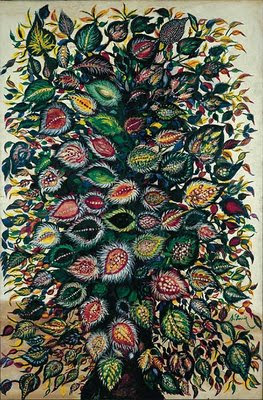 |
| Large Daisies, Senlis Museum |
It was in the quaint old town of Senlis that I discovered Seraphine Louis, the female naive painter whose extraordinary life was made into a movie that won seven Cesar awards. The excellent portrayal of Seraphine de Senlis by Yolande Moreau in the film has placed this relatively unknown artist back onto the map of art history.
Seraphine's mysterious and tragic life makes a compelling story. A self-taught artist, she never visited a museum or opened an art book. For many years she worked as a shepherdess and then a housekeeper before her talent was discovered in 1912 by German art collector Wilheim Uhde who was also a supporter of Henri Rousseau.
Seraphine was an artist consumed by an irrepressible urge to create. Her works are predominantly rich fantasies of haunting images of floral arrangement, but they are miles apart from the genre of 17th century Dutch still life. The intensity of her work, both in colour and design seems to parallel her own eccentric psyche, a state of mind that borders between madness and creative brilliance.
 Painting by candlelight and in complete isolation with the rest of the world, she was inspired by her religious faith and was driven by her own mystical visions to create amazing and beautiful pictures. Despite her immense talent, her success was short-lived. She died lonely and destitute in a mental asylum.
Painting by candlelight and in complete isolation with the rest of the world, she was inspired by her religious faith and was driven by her own mystical visions to create amazing and beautiful pictures. Despite her immense talent, her success was short-lived. She died lonely and destitute in a mental asylum.
It is worth noting that women artists in those days did not enjoy the same degree of recognition and creative freedom as their male counterparts. Female sculptor Camille Claudel also had a difficult career working with Auguste Rodin and she too ended up in a psychiatric hospital. Two artists, two women, two lives were left to the institutions and met their fateful death in the 1940s.
 Painting by candlelight and in complete isolation with the rest of the world, she was inspired by her religious faith and was driven by her own mystical visions to create amazing and beautiful pictures. Despite her immense talent, her success was short-lived. She died lonely and destitute in a mental asylum.
Painting by candlelight and in complete isolation with the rest of the world, she was inspired by her religious faith and was driven by her own mystical visions to create amazing and beautiful pictures. Despite her immense talent, her success was short-lived. She died lonely and destitute in a mental asylum.It is worth noting that women artists in those days did not enjoy the same degree of recognition and creative freedom as their male counterparts. Female sculptor Camille Claudel also had a difficult career working with Auguste Rodin and she too ended up in a psychiatric hospital. Two artists, two women, two lives were left to the institutions and met their fateful death in the 1940s.
 |
| Tree of Paradise Museum of Modern Art, New York |









![[IMAGE of a Monet Painting]](http://krypton.mnsu.edu/~schumann/www/images/monet_s2.jpg)



